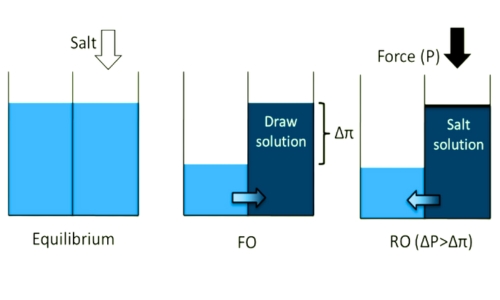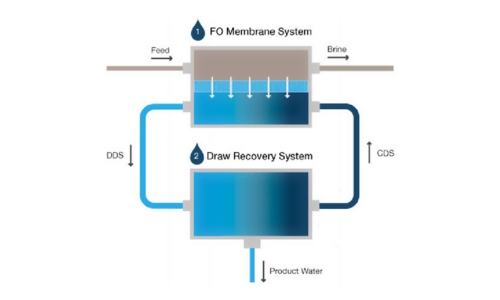INTRODUCTION
Forward osmosis (FO) is a technique that uses an osmotic pressure-driven semi-permeable membrane to separate water from dissolved compounds.
Osmotic pressure propels water over the membrane while maintaining the dissolved solutes on the other side. Water spontaneously leaves the treated liquid across a semi-permeable membrane during forward osmosis.
The water transfer in a forward osmosis system is driven by the potential chemical gradient between the draw solution on one side of the membrane and the liquid feed on the other [1].
 Figure 1: A schematic diagram of forward osmosis [2]
Figure 1: A schematic diagram of forward osmosis [2]
Principle
In contrast to many other membrane processes, such as reverse osmosis (RO), which uses supplied hydraulic pressure, forward osmosis (FO) is a process that is driven by differences in osmotic pressure between a feed and draw solution.
Forward Osmosis process
The FO process needs a semi-permeable membrane to divide the feed solution, which has a low osmotic pressure, and the draw solution, which is very concentrated. Since the primary operating expenditure for systems like RO is the energy required to pump solutions at high pressure, it is typically predicted that FO will have substantially lower energy expenses.
The draw solution is gradually diluted while the feed solution’s concentration increases due to water permeability across the membrane [3].
Advantages:
- Low energy usage per recovered unit of water.
- Low costs for operation and maintenance.
- Less fouling and scaling ability to handle complex wastewater.
Disadvantages:
- The amount of water wasted by the process
- It can dewater feeds loaded with fibres, sugars, and salts and has no osmotic pressure limitations [3].
Application
The latest natural concentrates:
Compared to fresh juices, most thermally evaporated fruit juice concentrates undergo processing steps that cause them to lose colour, flavour, and nutrient components. Forwards osmosis preserves the colour, nutrients, and sensory character of fruit juices while dehydrating them. One possible use for these concentrates is to swap out sugar additives for forwards osmosis dewatered juice, which provides vitamins, antioxidants, fibre, and other minerals. Before spray-drying to create powdered goods, forward osmosis concentrates may also be employed to offer high-grade concentrated food.

Figure 2: Forward Osmosis can be used to concentrate brine [4]
Savings on transportation:
Concentrates let firms save on logistics expenses, including storage, shipping, and others. Concentrates from forward osmosis techniques provide for shipping cost reductions without sacrificing product quality. To cut shipping expenses, tropical drinks like coconut water and mango, pineapple, or passion fruit juice can be concentrated five to ten times before delivery. Three billion tonnes less water would be delivered annually if coconut water were shipped, dewatered and rehydrated at the point of sale, saving energy.
Dewatering of Water-Alcohol Mixtures:
Additionally, forward osmosis may function with combinations of water-soluble solvents, such as water and alcohol. For instance, forward osmosis can eliminate water from alcohol while retaining or lowering the end product’s alcohol level-for example, concentrated wine. The wine concentration procedure may concentrate the alcohol in proportion to other ingredients, lower the alcohol content, and rehydrate the wine [1].





